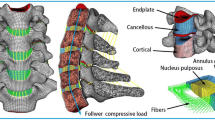Abstract
Purpose
Traditional Chinese medical massage is a physical manipulation that achieves satisfactory results on spinal diseases, according to its advocates. However, the method relies on an expert’s experience. Accurate analysis and simulation of massage are essential for validation of traditional Chinese physical treatment. The objective of this study is to provide analysis and simulation that can reproducibly verify and predict treatment efficacy.
Methods
An improved physical multi-deformation model for simulating human cervical spine is proposed. First, the human spine, which includes muscle, vertebrae and inter- vertebral disks, are segmented and reconstructed from clinical CT and MR images. Homogeneous landmark registration is employed to align the spine models before and after the massage manipulation. Central line mass spring and contact FEM deformation models are used to individually evaluate spinal anatomy variations. The response of the human spine during the massage process is simulated based on specific clinical cases.
Results
Ten sets of patient data, including muscle–force relationships, displacement of vertebrae, strain and stress distribution on inter-vertebral disks were collected, including the pre-operation, post-operation and the 3-month follow-up. The simulation results demonstrate that traditional Chinese massage could significantly affect and treat most mild spinal disease.
Conclusion
A new method that simulates a traditional Chinese medical massage operation on the human spine may be a useful tool to scientifically validate and predict treatment efficacy.
Similar content being viewed by others
References
Bolz J, Farmer I, Grinspun E, Schroder P (2003) Sparse matrix solvers on the GPU: conjugate gradients and multigrid. In: International conference on computer graphics and interactive techniques, ACM SIGGRAPH 2003 papers, p 917–924
Chai J, Sun J, Tang Z (2001) Hybrid FEM for deformation of soft tissues in surgery simulation. International workshop on medical imaging and augmented reality (MIAR ‘01), 2001, p 298
Chaichanasiri E, Nanakorn P, Tharanon W, Vander Sloten J (2009) A finite element study of the effect of contact forces between an implant-retained crown and its adjacent teeth on bone stresses. J Mech 25(4): 441–450
Cherkin DC, Eisenberg D, Sherman KJ, Barlow W, Kaptchuk TJ, Street J, Deyo RA (2001) Randomized trial comparing traditional Chinese medical acupuncture, therapeutic massage, and self-care education for chronic low back pain. Arch Intern Med 161: 1081–1088
Furukawa D, Kitasaka T, Mori K, Suenaga Y, Mase K, Takahashi T (2004) Spine posture estimation method from human images using 3D spine model computation of the rough approximation of the physical forces working on vertebral bodies. In: Proceedings of the 17th international conference on pattern recognition, 2004. ICPR 2004, 23–26 Aug 2004, vol 3, p 322–325
Georgii J, Echtler F, Westermann R (2005) Interactive simulation of deformable bodies on GPUs. In: Simulation and visualisation 2005, p 247–258
Georgii J, Westermann R (2005) Mass-spring systems on the GPU. In: Simulation modelling practice and theory, Vol 13, Issue 8, November 2005, p 693–702
Hirota G, Fisher S, State A (2003) An improved finite-element contact model for anatomical simulations. Vis Comput 2003(19): 291–309
Lin H, Sucato D (2004) Identification of lenke spine deformity classification by simplified 3D spine model. Engineering in medicine and biology society, 2004. IEMBS ‘04. 26th Annual international conference of the IEEE 2:3144–3146
Liu Y, Jiao S, Wu W, De S (2008) GPU accelerated fast FEM deformation simulation. Circuits and systems, APCCAS 2008, IEEE Asia Pac Conf p 606–609, Nov 30 2008–Dec 3 2008
Liu C, Jiang Z-H, Liu Y-L (2009) Standardized representation model and case application of TCM massage therblig. Comput Eng 35(11): 20–22,25
Lv S, Gu L, Pan L (2009) Delaunay mesh reconstruction from 3D medical images based on centroidal voronoi tessellations. In: Proceedings of the international conference on computational intelligence and software engineering, p 1–4
Nealen A, Müller M, Keiser R, Boxerman E, Carlson M (2005) Physically based deformable models in computer graphics. In: Eurographics 2005
Ranzuglia G, Cignoni P, Ganovelli F, Scopigno R (2006) Implementing mesh-based approaches for deformable objects on GPU. In: Fourth eurographicsItalian chapter, eurographics association, p 213–218, Feb 2006
Rohlmann A, Mann A, Zander T, Bergmann G (2009) Effect of an artificial disc on lumbar spine biomechanics: a probabilistic finite element study. Eur Spine J 18(1): 89–97
Author information
Authors and Affiliations
Corresponding author
Rights and permissions
About this article
Cite this article
Pan, L., Yang, X., Gu, L. et al. Validation and prediction of traditional Chinese physical operation on spinal disease using multiple deformation models. Int J CARS 6, 201–208 (2011). https://doi.org/10.1007/s11548-010-0500-1
Received:
Accepted:
Published:
Issue Date:
DOI: https://doi.org/10.1007/s11548-010-0500-1




